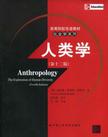人类学
2008年
中国人民大学出版社
科塔克
417
庄孔韶,冯越
无
讲坛耕耘四十载,精髓浓缩十余回。读者手中的这本《人类学》经典双语教材由北美资深人类学家科塔克教授编撰完成。它不仅是作者近四十年学术累积的硕果,更是在不断的版本更新中获得化蛹为蝶的力量,堪称北美人类学教材中的典范。 文化素来以语言为其重要载体,直接的英文阅读所带来的思维转换与意义提升是我们多年来不断追寻的目标,这里我们依然希望读者能够在这本融知识、信息及语言魅力于一体的典范教材中获得思想的进一步提升。 请在跨语境的阅读中跟随我们共享人类的文化之旅!
康拉德•菲利普•科塔克教授(Conrad Phillip Kottak),1966年获哥伦比亚大学人类学博士学位,现为美国密歇根大学人类学系教授。自1968年开始在密歇根大学人类学系任教以来,科塔克教授在人类学教学及研究方面成果颇丰、1991年荣获密歇根大学荣誉教师称号,19
第一部分 人类学的领域 第1章 什么是人类学? 第2章 应用人类学第二部分 体质人类学与考古学 第3章 伦理规范与研究方法 第4章 进化与遗传学 第5章 人类的变化及适应 第6章 灵长类动物 第7章 灵长类动物的进化 第8章 早期人猿 第9章 人属 第10章 早期的农人 第11章 早期的城市与国家第三部分 文化多样性 第12章 文化人类学研究方法 第13章 文化 第14章 族性与种族 第15章 语言与交际 第16章 生活方式 第17章 政治系统 第18章 家庭、亲属制度与继嗣 第19章 婚姻 第20章 性别 第21章 宗教 第22章 艺术第四部分 变化中的世界 第23章 现代世界体系 第24章 殖民主义与发展 第25章 文化变革与生存 附录1:人类学理论史 附录2:伦理规范与人类学
Neandertals were first discovered in Western Europe. The first one was found in 1856 in a Ger- man valley called Neander Valley-tal is the Ger- man word "for a valley. Scientists had trouble interpreting the discovery. It was clearly human and similar to modern Europeans in many ways, yet different enough to be considered strange and abnormal. This was, after all, 35 years before Dubois discovered the first H. erectus fossils inJava and almost 70 years before the first australo-pithecine was found in South Africa. DarwinsOn the Origin of Species, published in 1859, hadnot yet appeared to offer a theory of evolutionthrough natural selection. There was no frame-work for understanding human evolution. Overtime, the fossil record filled in, along with evolu-tionary theory. There have been numerous subse-quent discoveries of Neandertals in Europe andthe Middle East and of archaic human fossilswith similar features in Africa and Asia. The sim-ilarities and differences between Neandertalsand other relatively recent hominins have becomeclearer. Fossils that are not Neandertals but that havesimilar features (such as large faces and browridges) have been found in Africa and Asia. TheKabwe skull from Zambia (130,000 B.P.), shownin the photo below, is an archaic H. sapiens with aNeandertal-like brow ridge. Archaic Chinesefossils with Neandertal-like features have beenfound at Maba and Dali. Neandertals have beenfound in Central Europe and the Middle East. Forexample, Neandertal fossils found at the Shanidarcave in northern Iraq date to around 60,000 B.P., asdoes a Neandertal skeleton found at IsraelsKebara cave (Shreeve 1992). At the Israeli site ofTabun on Mount Carmel, a Neandertal femaleskeleton was excavated in 1932. She was a contem-porary of the Shanidar Neandertals, and her browridges, face, and teeth show typical Neandertalrobustness.By 75,000 B.P., after an interglacial interlude, West-ern Europes hominins (Neandertals, by then)again faced extreme cold as the W/inn glacialbegan. To deal with this environment, they woreclothes, made more elaborate tools, and huntedreindeer, mammoths, and woolly rhinos. The Neandertals were stocky, with largetrunks relative to limb length:a phenotype thatminimizes surface area and thus conserves heat.Another adaptation to extreme cold was theNeandertal face, which has been likened to a H.erectus face that has been pulled forward by thenose. Illustrating Thomsons rule (see Chapter 5),this extension increased the distance betweenoutside air and the arteries that carry blood to thebrain and was adaptive in a cold climate. Thebrain is sensitive to temperature changes andmust be kept warm. The massive nasal cavities ofNeandertal fossils suggest long, broad noses.This would expand the area for warming andmoistening air. Neandertal characteristics also include hugefront teeth, broad faces, and large brow ridges,and ruggedness of the skeleton and musculature.What activities were associated with theseanatomical traits? Neandertal teeth probably didmany jobs later done by tools (Brace 1995; Rak1986). The front teeth show heavy wear, suggest-ing that they were used for varied purposes,including chewing animal hides to make softwinter clothing out of them. The massive Nean-dertal face showed the stresses of constantlyusing the front teeth for holding and pulling. Comparison of early and later Neandertalsshows a trend toward reduction of their robust fea-tures. Neandertal technology, a Middle Paleolithictradition called Mousterian, improved consider-ably during the Wtirm glacial. Tools assumedmany burdens formerly placed on the

无